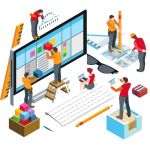The Rise of AI and Machine Learning in Software Development
Artificial Intelligence (AI) and Machine Learning (ML) are transforming industries worldwide, and software development is no exception. These technologies are revolutionizing how developers approach problem-solving, code creation, testing, and deployment. In this blog post, we’ll explore the impact of AI and ML on software development, the opportunities they present, and the challenges developers face as they adapt to this rapidly evolving landscape.
1. AI and ML: A Brief Overview
AI refers to the simulation of human intelligence processes by machines, especially computer systems. These processes include learning (the acquisition of information and rules for using the information), reasoning (using rules to reach approximate or definite conclusions), and self-correction. ML, a subset of AI, involves the use of algorithms that allow computers to learn from and make decisions based on data.
In the context of software development, AI and ML can be used to automate tasks, optimize processes, and even create software applications with minimal human intervention. The integration of these technologies is enabling developers to build more efficient, scalable, and intelligent systems.
2. AI-Driven Code Generation and Optimization
One of the most exciting applications of AI in software development is automated code generation. Tools like GitHub Copilot, powered by OpenAI’s Codex, can assist developers by suggesting code snippets, functions, or even entire classes based on the context of what they’re working on. This can significantly speed up development time and reduce the likelihood of errors.
Key Benefits:
- Increased Productivity: Developers can write code faster with AI-driven suggestions and automation.
- Code Quality: AI can help ensure that the code adheres to best practices and is free from common errors.
- Learning Aid: Junior developers can benefit from AI-driven tools by learning best practices and common coding patterns as they code.
Challenges:
- Dependence on AI: Over-reliance on AI for code generation can lead to a lack of deep understanding of the underlying code.
- Security Risks: Automatically generated code might introduce vulnerabilities if not carefully reviewed.
3. Enhanced Software Testing with AI and ML
AI and ML are also making a significant impact on software testing. Traditional testing methods can be time-consuming and often require a large amount of manual effort. AI-driven testing tools can automate test case generation, identify potential edge cases, and even predict where bugs are most likely to occur.
Key Benefits:
- Efficiency: Automated testing can run continuously, identifying bugs faster and more efficiently than manual testing.
- Coverage: AI can generate a wider range of test cases, including edge cases that might be missed by human testers.
- Predictive Analytics: ML algorithms can analyze past bugs to predict and prevent future issues.
Challenges:
- Complexity: Integrating AI into the testing process requires a deep understanding of both the software and the AI models.
- Trust: Developers and testers need to trust AI-driven tools to make accurate and reliable decisions.
4. Intelligent Debugging and Error Detection
Debugging is a crucial part of the software development process, and AI is enhancing this area as well. AI-powered debugging tools can analyze large amounts of data to pinpoint the root cause of issues more quickly than traditional methods.
Key Benefits:
- Speed: AI can sift through logs and codebases to identify issues much faster than manual debugging.
- Accuracy: AI can detect subtle bugs that might be missed by human developers.
- Proactive Solutions: Some AI tools can not only identify issues but also suggest potential fixes.
Challenges:
- Interpretability: Understanding how an AI arrived at a particular conclusion can be difficult, especially for complex issues.
- Over-reliance: Developers might become too dependent on AI tools, potentially missing out on important learning opportunities.
5. The Role of AI in Software Design and Architecture
AI and ML are increasingly being used to optimize software design and architecture. By analyzing vast amounts of data, AI can suggest the most efficient design patterns, architecture choices, and even help in refactoring existing codebases to improve performance and maintainability.
Key Benefits:
- Optimized Design: AI can analyze design patterns and suggest the most efficient solutions based on historical data and current best practices.
- Scalability: AI can predict scalability issues and suggest architectural changes to handle growing loads.
- Continuous Improvement: AI can continuously analyze and improve the software architecture as new data becomes available.
Challenges:
- Complex Decision-Making: Relying on AI for design and architectural decisions can be risky if the AI lacks the contextual understanding of the specific project.
- Integration: Incorporating AI into the design process requires careful consideration to ensure it complements human expertise.
6. The Future of AI and ML in Software Development
The integration of AI and ML in software development is still in its early stages, but the potential is vast. As these technologies continue to evolve, they will likely become even more integral to the development process, enabling the creation of more intelligent, adaptive, and efficient software.
Predictions:
- Increased Automation: More aspects of the development process, from coding to deployment, will become automated.
- AI-Enhanced Collaboration: AI tools will facilitate better collaboration between developers by providing real-time insights and suggestions.
- New Roles and Skills: As AI takes over more routine tasks, developers will need to focus on higher-level problem-solving and creativity, leading to the emergence of new roles and skill sets in the industry.
Conclusion
The rise of AI and ML in software development is transforming the industry, offering exciting opportunities for increased efficiency, improved code quality, and more intelligent systems. However, these advancements also come with challenges that developers must navigate carefully. As AI continues to evolve, its role in software development will only grow, making it essential for developers to understand and leverage these technologies effectively.
Whether you’re just beginning your journey in AI-driven development or are looking to enhance your existing practices, staying informed and adaptable will be key to thriving in this new era of software development.


